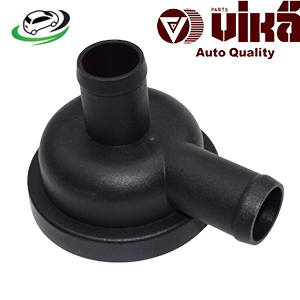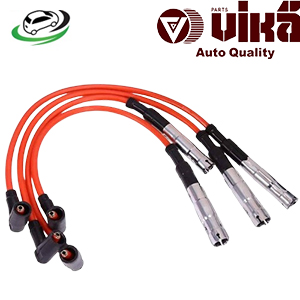-5%
Get AUDI A3 1997-2000 / VW Golf Mk4 1998-2001 Ignition Lead 06A905430E
The ignition lead, also known as the spark plug wire or ignition cable, is a crucial component in an internal combustion engine’s ignition system. Its primary function is to transfer electrical energy from the ignition coil to the spark plugs, enabling the combustion process that powers the engine. In this detailed exploration, we will delve into the anatomy, functions, types, advantages, common issues, and maintenance of ignition leads.
1. What is an Ignition Lead?
An ignition lead is an insulated wire that connects the ignition coil to the spark plug in gasoline engines. When the ignition coil generates a high-voltage electrical charge, the ignition lead conducts this charge to the spark plug. The spark plug then creates a spark that ignites the air-fuel mixture in the combustion chamber, initiating the engine’s power stroke.
Anatomy of an Ignition Lead
An ignition lead typically consists of the following components:
- Conductive Core: The core of the ignition lead is usually made of copper or aluminum, which conducts electricity efficiently. In some high-performance leads, a carbon core may be used to minimize electromagnetic interference (EMI).
- Insulation: Surrounding the conductive core is a layer of insulation, typically made of silicone, rubber, or other heat-resistant materials. This insulation prevents the electrical current from escaping and protects the wire from heat and corrosion.
- Boots: At both ends of the ignition lead, there are rubber or silicone boots that connect the lead to the ignition coil and the spark plug. These boots provide a secure connection and help seal against moisture and contaminants.
2. How Do Ignition Leads Work?
The ignition lead plays a critical role in the ignition process of an internal combustion engine. Here’s how it works:
- Voltage Generation: When the ignition switch is turned on, the ignition coil generates a high-voltage electrical charge. This charge can range from 12,000 volts to over 45,000 volts, depending on the engine and ignition system design.
- Electrical Transfer: The high-voltage current travels through the ignition lead from the ignition coil to the spark plug. The lead must be capable of withstanding the high voltage without breaking down or arcing.
- Spark Creation: Once the electrical current reaches the spark plug, it jumps across the spark plug’s electrode gap, creating a spark. This spark ignites the compressed air-fuel mixture in the combustion chamber, causing an explosion that drives the piston down and powers the engine.
- Repeat Cycle: This process happens multiple times per minute as the engine runs, necessitating the need for reliable ignition leads that can withstand the stress of repeated electrical surges.
3. Types of Ignition Leads
Ignition leads can vary in design and construction based on the ignition system type and performance requirements. The main types include:
1. Standard Ignition Leads
These leads are typically made with a copper core and rubber or silicone insulation. They are designed for regular driving conditions and are suitable for most vehicles. Standard ignition leads provide reliable performance at a reasonable cost.
2. High-Performance Ignition Leads
High-performance ignition leads are designed for racing or modified engines that require higher voltage and more precise timing. These leads often feature:
- Carbon Core: This type of core reduces electromagnetic interference and radio frequency interference (RFI), providing a cleaner signal to the spark plug.
- Heavy-Duty Insulation: They are constructed with high-temperature silicone or reinforced materials to withstand extreme conditions, such as high heat and vibration.
3. Resistor Ignition Leads
Resistor ignition leads contain a built-in resistor that helps reduce electrical noise and interference. This type is particularly beneficial for vehicles equipped with sensitive electronics, as it prevents the ignition system from interfering with other electrical components.
4. Solid-Core Ignition Leads
Solid-core ignition leads consist of a single solid wire, usually copper. They are highly conductive but can generate significant electrical noise, which may interfere with other electrical systems. Solid-core leads are more commonly found in older vehicles or specialized applications.
4. Benefits of High-Quality Ignition Leads
Investing in high-quality ignition leads can lead to several advantages:
- Improved Engine Performance: High-quality leads provide better conductivity and consistent voltage delivery to the spark plugs, resulting in more efficient combustion and improved engine performance.
- Enhanced Fuel Efficiency: By ensuring that the air-fuel mixture ignites more effectively, quality ignition leads can help optimize fuel consumption, leading to better fuel economy.
- Longer Lifespan: Premium ignition leads made from durable materials can withstand extreme temperatures, vibrations, and corrosion, resulting in a longer lifespan compared to cheaper alternatives.
- Reduced Emissions: Proper ignition leads contribute to complete combustion of the air-fuel mixture, helping reduce harmful emissions from the exhaust system.
5. Common Issues with Ignition Leads
Over time, ignition leads can experience wear and tear, leading to various problems. Some common issues include:
1. Cracks and Damage
The insulation on ignition leads can crack or wear out due to exposure to high temperatures, chemicals, and mechanical stress. Cracked insulation can lead to arcing, where the electrical current escapes from the wire, resulting in misfires and poor engine performance.
2. Corrosion
Corrosion can occur at the connection points between the ignition lead and the ignition coil or spark plug. This can lead to poor electrical contact, resulting in voltage loss and misfires.
3. Short Circuits
A short circuit can occur if the insulation is compromised, allowing the conductive core to contact other engine components or wires. This can result in erratic spark delivery and engine performance issues.
4. Worn Connectors
The boots that connect the ignition leads to the ignition coil and spark plugs can wear out or become loose over time. Worn connectors can lead to poor electrical connections, resulting in misfires or starting issues.
5. Increased Resistance
As ignition leads age, their resistance can increase, resulting in a weaker spark at the spark plug. This can lead to incomplete combustion, rough idling, and decreased performance.
6. Signs of Failing Ignition Leads
Detecting a failing ignition lead early can help prevent further engine damage and performance issues. Some common symptoms include:
- Engine Misfires: A faulty ignition lead may cause the engine to misfire, resulting in rough idling or poor acceleration.
- Hard Starting: Difficulty starting the engine can indicate problems with the ignition leads, as weak or inconsistent voltage may prevent the spark plugs from firing properly.
- Reduced Power: A noticeable decrease in engine power, especially during acceleration, may indicate ignition lead issues.
- Check Engine Light: An illuminated check engine light can be triggered by misfires or other ignition-related problems, prompting a diagnostic check.
- Increased Fuel Consumption: If the ignition leads are failing, the engine may consume more fuel than usual due to incomplete combustion.
7. Maintenance of Ignition Leads
Regular maintenance of ignition leads can help ensure their optimal performance and extend their lifespan. Here are some maintenance tips:
1. Regular Inspections
Periodically inspect ignition leads for signs of wear, such as cracks, fraying, or corrosion at the connectors. If any issues are detected, consider replacing the leads promptly.
2. Clean Connectors
Keep the connectors clean and free from corrosion. A small amount of electrical contact cleaner can be used to remove any buildup that may affect the electrical connection.
3. Check for Proper Routing
Ensure that the ignition leads are routed correctly and not in contact with hot engine components or moving parts. Proper routing helps prevent damage to the leads and maintains their integrity.
4. Replace When Necessary
Most manufacturers recommend replacing ignition leads every 60,000 to 100,000 miles, or as specified in the vehicle’s maintenance schedule. If you notice any signs of wear or performance issues, consider replacing them sooner.
5. Use Quality Parts
When replacing ignition leads, opt for high-quality aftermarket or OEM parts to ensure optimal performance and longevity.
Conclusion
The ignition lead is a vital component of an internal combustion engine’s ignition system, playing a crucial role in transferring high-voltage electrical energy from the ignition coil to the spark plugs. Understanding the function, types, benefits, common issues, and maintenance of ignition leads can help vehicle owners ensure optimal engine performance and longevity. By investing in quality ignition leads and performing regular inspections, you can maintain your engine’s efficiency, reduce emissions, and enjoy a smooth driving experience. Regular maintenance and timely replacement of worn ignition leads are key to keeping your engine running smoothly and efficiently for years to come.
Follow us on Facebook for more parts.




Reviews
Clear filtersThere are no reviews yet.